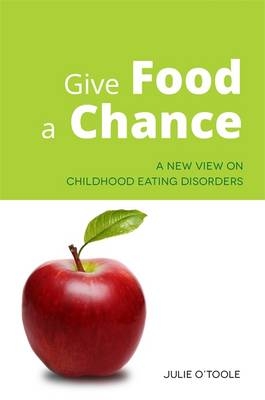
Give Food a Chance
Jessica Kingsley Publishers (Verlag)
978-1-84905-731-8 (ISBN)
- Titel ist leider vergriffen;
keine Neuauflage - Artikel merken
Drawing on more than a decade's experience as director of The Kartini Clinic, Julie O'Toole offers a fresh perspective on childhood eating disorders and invaluable insights for parents and professionals.
Describing the foundational philosophy behind The Kartini Clinic's proven and world-renowned treatment protocol, O'Toole presents compelling evidence that childhood eating disorders have a neurological rather than a psycho-social basis, and explains what this means for treatment. She describes clearly what patients and families can expect from treatment, signs and symptoms indicating the need for hospitalization, and advice on how to recognise a relapse. The book also includes clear descriptions of The Kartini Clinic's ground-breaking Meal Plan and approach to 'capping' weight gain.
Give Food a Chance is an invaluable resource that will give parents and professionals everywhere the information, encouragement, and support they need to deal with this often misunderstood disorder.
Julie O'Toole, MD, MPH CEDS is founder and Chief Medical Officer of Kartini Clinic for Children and Families in Portland, Oregon. She is a board certified pediatrician and has been in private pediatric practice for more than two decades. She is a member of the Academy for Eating Disorders (AED), the American Academy of Pediatrics, the Society for Adolescent Medicine, NEDA (National Eating Disorders Association), and a Certified Eating Disorder Specialist (CEDS). She also has a master's degree in public health (international health).
Preface. Acknowledgements. Epigraph. 1. Introduction. 1.1. Our patients are our teachers. 2. It's a jungle out there. 2.1. Psychoanalysis. 2.2. Hilde Bruch. 2.3. Feminist theory. 2.4. Family-blaming theories. 2.5. The media. 2.6. Current attitudes in adolescent medicine. 2.7. Insights from cross-cultural medicine. 2.8. The way we talk. 3. Why won't my doctor listen? 3.1. Weight loss and failure to gain weight. 3.2. Ascertaining the seriousness of weight loss. 3.3. Common clinical presentations. 3.4. Common physical manifestations. 3.5. Common laboratory findings. 3.6. Other medical disorders presenting as weight loss. 3.7. A word about parents. 4. Eating disorders of childhood. 4.1. Anorexia nervosa. 4.2. Bulimia nervosa. 4.3. Selective eating. 4.4. Food phobia/functional dysphagia. 4.5. Dieting gone awry: Imitative forms. 5. It is not the parents' fault. 5.1. Children do not choose to have anorexia nervosa. 6. When insurance refuses to pay. 6.1. The cost of not referring. 7. Are you telling me it's a brain disorder? 7.1. Neuroimaging. 8. What heritability means and what it does not. 9. What happens when my child won't eat? 9.1. The Minnesota semi-starvation study. 10. Psychopharmacology. 11. What is the role of family? 11.1. Unity within the team. 12. What should I expect...? 12.1 Preconsult. 12.2. Arrival and vitals. 12.3. Physical exam. 12.4. REDS Interview. 12.5. Parental consult. 12.6. Hospitalization. 12.7. Outpatient follow-up. 13. My child has to go to the hospital? 13.1. When to admit. 13.2. The Kartini inpatient eating-disorder unit. 13.3. Medication. 14. Finally my child is eating...what's next? 14.1. The day treatment unit. 14.2. The day treatment program for college-age-youth. 14.3. Special Issues in the treatment of young adults. 15. Is anorexia nervosa chronic or curable? 15.1. Maudsley and our family-based outpatient care. 15.2. Is anorexia nervosa a chronic illness? 15.3. The Kartini clinic meal plan (KCMP). 15.4. Outpatient interventions at the Kartini clinic. 15.5. The outpatient course of illness. 15.6. Weight gain and body fat redistribution. 15.7. Ideal body weight. 15.8. Impediments to healing a child. 15.9. No professional anorexics. 16. Food phobia. 16.1. Definition. 16.2. Clinical conundrum. 16.3. Use of medication. 16.4. Naso-gastric feeds. 16.5. Waiting...and waiting. 16.6. Introducing food: Bite, chew, swallow. 16.7. Food phobia case histories. 16.8. Discussion. References. Appendix A: Rating of eating disorder severity (REDS). Appendix B: Family history questionnaire for parents. Appendix C: Eating disorder hospital protocol and phases. Appendix D: Eating disorder admission orders. Index.
| Erscheint lt. Verlag | 21.3.2015 |
|---|---|
| Verlagsort | London |
| Sprache | englisch |
| Maße | 152 x 228 mm |
| Gewicht | 440 g |
| Themenwelt | Sachbuch/Ratgeber ► Gesundheit / Leben / Psychologie ► Ernährung / Diät / Fasten |
| Medizin / Pharmazie ► Medizinische Fachgebiete ► Pädiatrie | |
| Medizin / Pharmazie ► Medizinische Fachgebiete ► Psychosomatik | |
| Medizin / Pharmazie ► Medizinische Fachgebiete ► Psychiatrie / Psychotherapie | |
| ISBN-10 | 1-84905-731-1 / 1849057311 |
| ISBN-13 | 978-1-84905-731-8 / 9781849057318 |
| Zustand | Neuware |
| Haben Sie eine Frage zum Produkt? |
aus dem Bereich


